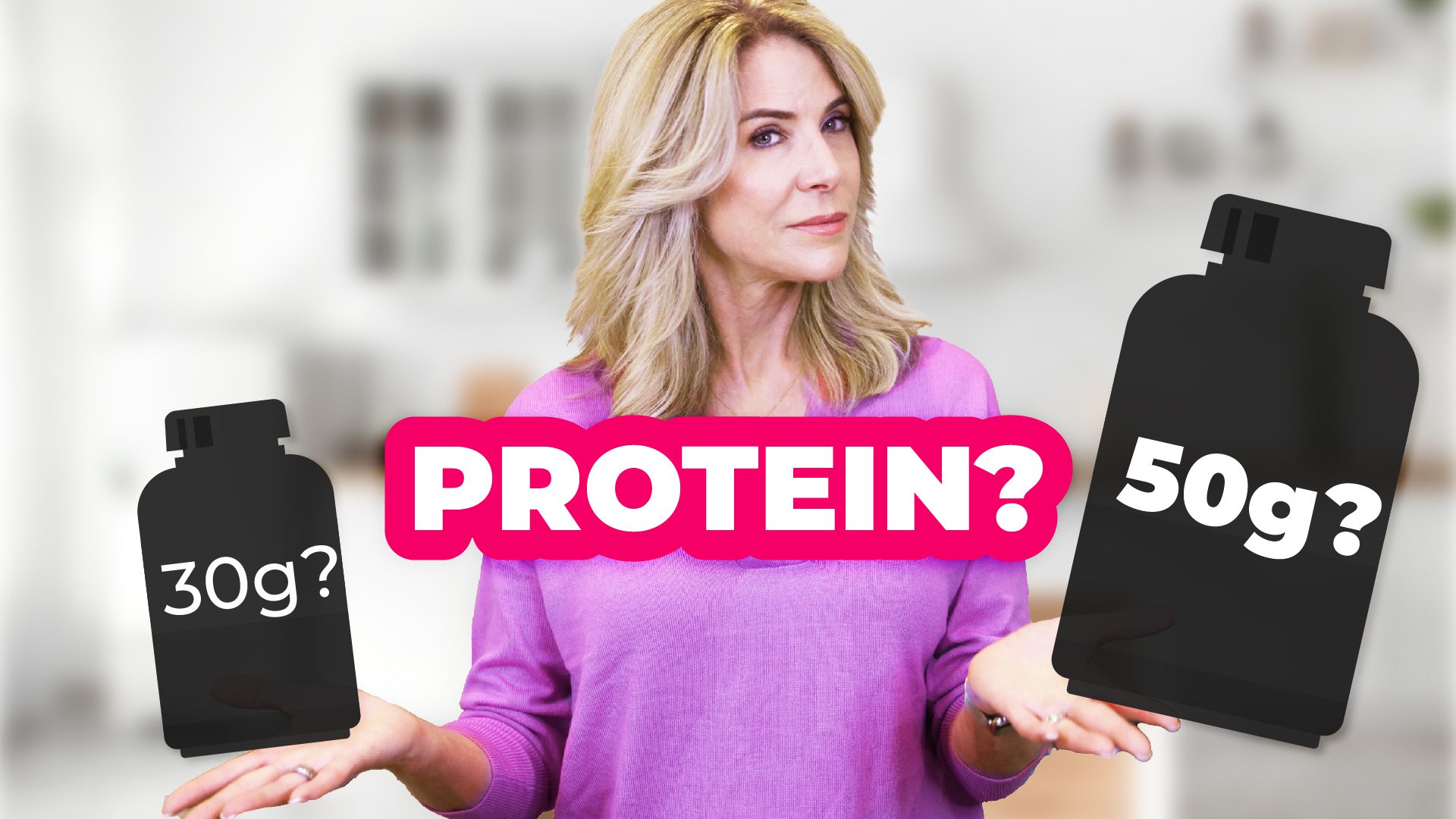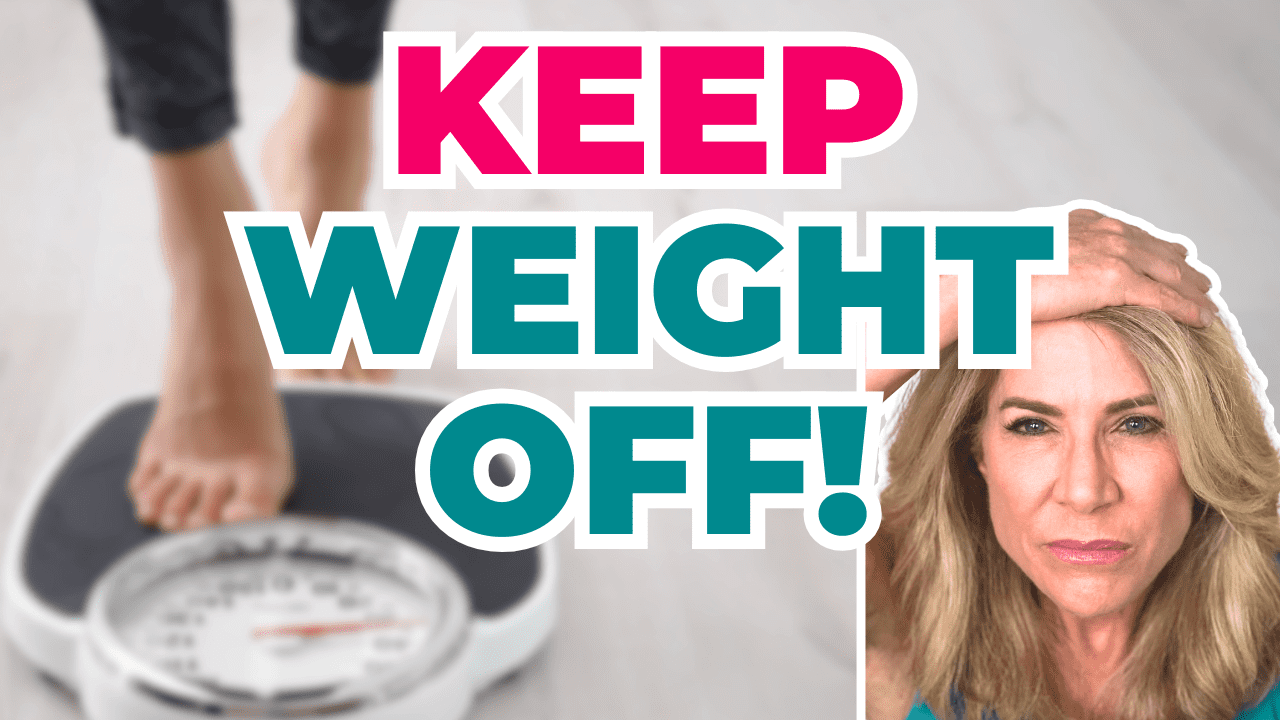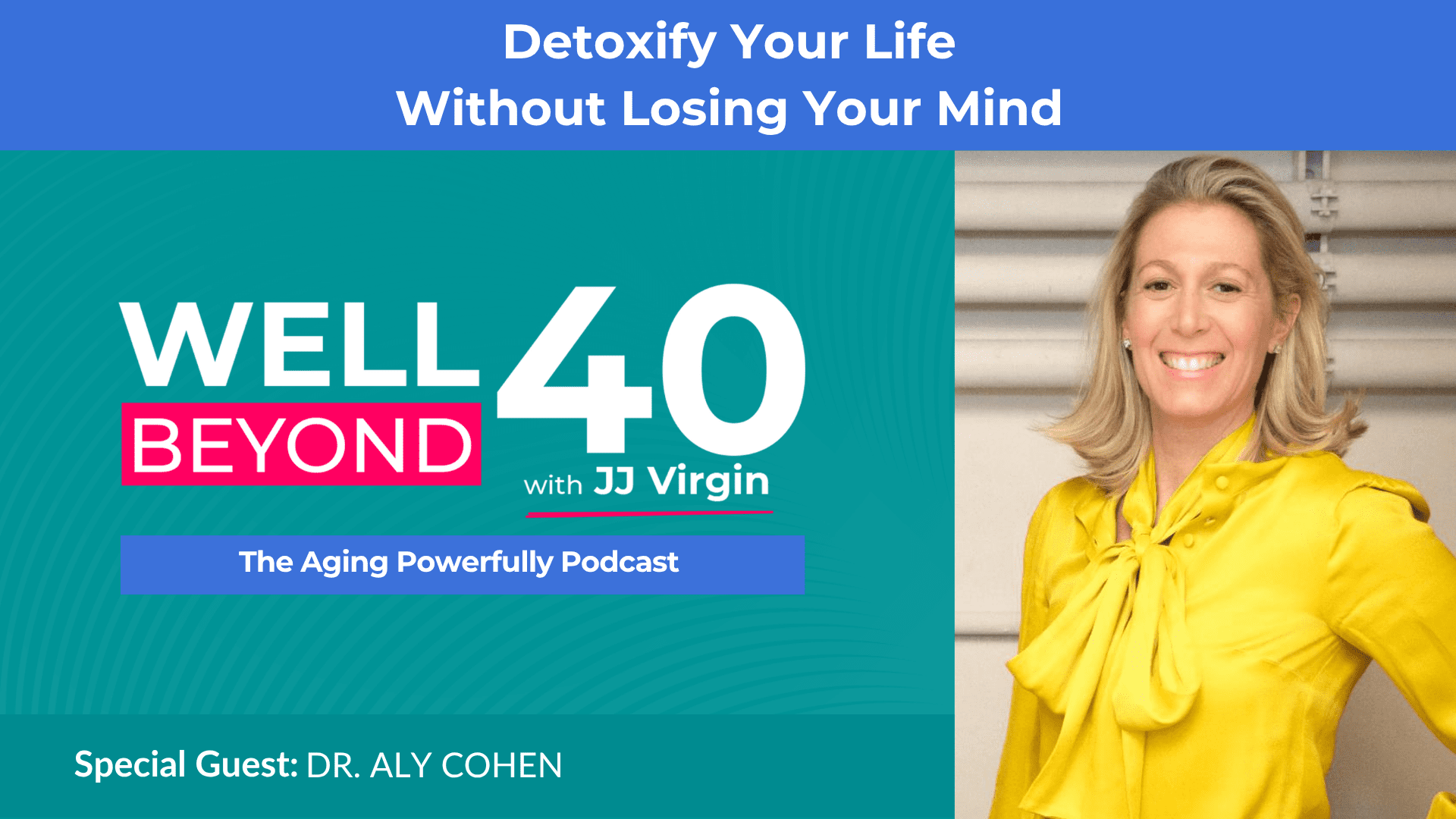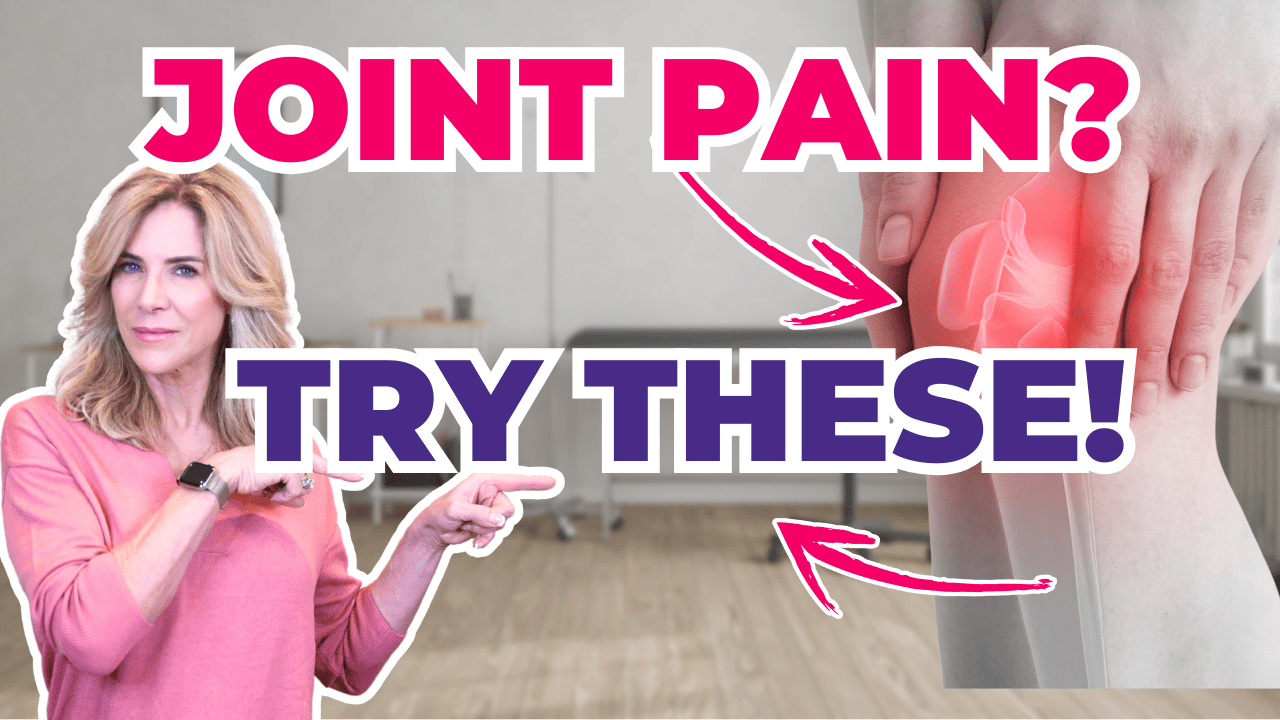Are You Getting Enough to Reach Your Goals?
Are you over 40 and hoping to burn fat, build muscle, and feel your best?
Have you been working out and not seeing results?
If you said yes to either of those questions, I have one word for you: protein. The fact is, if you’re not getting enough protein, you’re going to have a hard time achieving your fitness goals. Not only that, it could take a truly devastating toll on your health and your metabolism.
In this episode, you’ll learn everything you need to know about how much protein to eat, what kind of protein to eat, and when to eat it. I’m also explaining how vegetarians and vegans can get enough protein to build muscle and burn fat—without eating too much.
If you’re ready to change your body, you don’t want to miss this episode!
Timestamps
00:01:00 – Is the recommended daily intake of protein enough?
00:02:06 – There’s only one macronutrient you must get every day
00:03:45 – How age, stress, and more affect your protein needs
00:05:27 – What happens if you get too much protein?
00:07:27 – When should you eat protein?
00:08:03 – What are the best sources?
00:12:28 – The challenge for vegans & vegetarians
00:15:09 – How do you know you’re getting what you need?
Resources Mentioned in this episode
Watch the FULL VIDEO on my YouTube Channel
Learn how foods cause leaky gut in The Virgin Diet
Get your grass-fed beef, free-range organic chicken, and more delivered directly to your door from Butcherbox
Get your fish and seafood protein from Vital Choice
Track your protein with Cronometer App
Reignite Wellness™ All-In-One Shakes
Reignite Wellness™ Collagen Peptides Powder
Good Karma Flax Milk + Protein
Take a food intolerance test through YourLabWork
Reignite Wellness™ Clean Creatine Powder
Reignite Wellness™ Amino Power Powder
Video: I Tracked Macros for 30 Days, Here’s What Happened
ATHE_Transcript_Ep 596_How Much Protein You REALLY Need for Fat Loss & Muscle Building Over 40
JJ Virgin: [00:00:00] I’m JJ Virgin, PhD dropout, sorry mom, turned four time New York Times best selling author. Yes, I’m a certified nutrition specialist, fitness hall of famer, and I speak at health conferences and trainings around the globe. But I’m driven by my insatiable curiosity and love of science to keep asking questions, digging for answers, and sharing the information I uncover with as many people as I can.
And that’s why I created the Well Beyond 40 podcast to synthesize and simplify the science of health into actionable strategies to help you thrive. In each episode, we’ll talk about what’s working in the world of wellness, from personalized nutrition and healing your metabolism, to healthy aging and prescriptive fitness.
Join me on the journey to better health, so you can love how you look and feel right now, and have the energy to play full out.[00:01:00]
If you’re getting in the recommended daily intake for protein every day, you’re actually not eating enough. And by the way, that can have devastating effects on both your metabolism and your body composition. Now, if you’re looking to improve your body composition and you’re 40 plus, protein needs to be one of your secret weapons.
And I’m guessing that unless you’ve been actively tracking it. You’re like most women and you’re getting somewhere between 40 to 65 grams a day. Now, you may think you’re doing fine because you’re hitting the RDA, but the reality is the RDA is really the bare minimum to avoid abject deficiencies. It’s not the optimal amount that you need to build muscle and burn fat as you age.
And we know now that you need neoprotein as you age due to a phenomenon called anabolic resistance, where it’s actually harder for you to build muscle. with protein and resistance training. Now, I’m going to break down how much you need and show you what you need to do so that you get what you need in every [00:02:00] single day.
But first, let’s talk about why protein is so important for muscle building and fat loss. We’ve got three macronutrients, right? Protein, fat, and carbs. And protein is the only macronutrient that you really have to eat every single day because unlike carbs and fat, we don’t have a great place to store amino acids.
You store them in your muscles, that’s going to be the reservoir, but you don’t want to go in there and start breaking down muscle to get more amino acids. So we have essential, we have conditional, we have non essential amino acids. The essential ones are the ones that you cannot make. And these are the ones that you’ve got to get in, right?
Can’t make them from the other amino acids. Now, protein’s critical because it’s used for building or repair. It’s not ideally a fuel source, but here’s the cool thing. If you overeat on protein, you can convert it to glucose and use it as needed. So if you overeat on it, it’s going to take a little bit more work to get it to use for fuel, which is good, right?
That’s more thermic. So [00:03:00] you’re covered. All right. So let’s talk about the benefits of protein because there’s so many of them. First of all, Satiety. And this is a big deal. I mean, if you’re hungry, all bets are off, right? So protein is by far the most satiating of the macronutrients. Second is blood sugar.
When you’re eating protein, especially I like to say eat protein first, it helps you have better blood sugar control. Turns out too, when you eat protein first, research shows that you make better food choices overall. And protein is the most thermic of all of the macronutrients. We have protein, we have fat, we have carbs.
Protein takes about 20 to 30 percent of its calories to be assimilated, to be used by the body. Contrast that with carbohydrates, probably 10 percent and fat, really nothing. Fat’s very easily used. Now here’s the mission critical thing. Protein needs increase with your age. So as we age, we don’t need less, we need more.
But there are some other things that also increase our protein needs. Stress. If you’re a vegan or vegetarian, because one [00:04:00] of the things you’ll get from plant based protein or animal based protein rather, is you’re going to get the right blend of essential amino acids. Not so with most of the vegan sources.
Soy is one of the few things that tends to be better, but still not optimal. And so if you’re vegan, you’re going to need more. All right. You’ll also need more if you’re doing heavy workouts. Or if you’re recovering from an injury, you’ll need more as well. And I said protein, you needed more as you aged.
Here’s why. As we age, we start to suffer with something called anabolic resistance. This is when you have a blunted stimulation of muscle protein synthesis. And so typically we get good muscle protein synthesis from eating protein and getting enough leucine to trigger it and from resistance training.
But this goes down as we age, which means We need more. So how much do you really need? I actually created a calculator to help you figure this out and put in all those variables I just talked about. And you can get that at [00:05:00] jjvirgin.com/proteincalculator. But let me just walk you through this.
First of all, think about getting somewhere between 0. 7 to 1 gram per pound of target body weight. That is the body weight that you want to be, not the body weight you are currently at. So 0. 7 to 1 gram per pound of target body weight. You will need more as we age. If you’re a vegan, if you’re actively trying to build muscle, if you’re under a lot of stress, if you’re injured, go to the higher level of the range.
I am more concerned about you not getting enough than I’m concerned about you getting a little too much. Cause if you get too much, your body will break it down and use it as fuel, right? It’s not just going to hang out there. Your body will still use it. I know there’s all this stuff about, we can only assimilate so much.
We can only assimilate so much and use it to store it as amino acids in our muscles, but we’ll still use it for something. We can turn it into glucose and store it as glycogen. There’s other ways to use it. So, again, I’d rather you err a little bit on the high side than not get enough. So, Not only are you looking at getting that [00:06:00] 0.7 to 1 gram per pound of target body weight, you want to divide that between your meals. So I kind of say my floor for protein for adults is 100 grams. That’s the floor. And then for each meal, the minimum is about 30 grams. Why? And more if it’s a vegan meal, I’d take you up to more like 40 grams, because I want you to get enough of the amino acid.
Leucine, 2. 5 to 3 grams, because that leucine acts as a trigger for something called mTOR to get your body to go into muscle protein synthesis. So think about 30 grams as your bare minimum at a meal. And you don’t want to drip protein. You don’t want to eat protein all throughout the day, like breakfast, a snack, lunch, a snack.
No, you want to eat three meals a day. If you’re doing intermittent fasting, you can press your feeding window down to two, which isn’t going to be ideal if you’re really working on building muscle, by the way. Then you’re going to have to up your protein at those levels. at those meals. But think about three meals a day, 30 grams of protein or more at each meal, especially the first meal and the last meal.
Because when you eat that first meal, you’re shutting down muscle protein breakdown by [00:07:00] eating that protein that’s going to trigger that mTOR that’s going to trigger muscle protein synthesis and stop you from breaking down muscle, right? Because if we’re always in a state, your muscle’s very active, it’s building up, it’s breaking down, it’s building up and breaking down, right?
That’s part of the process. It’s very metabolically active. And same thing at night, when you eat your last meal about three hours before bed, get at least 30 grams of protein, maybe a little more so that you don’t go into muscle protein breakdown as quickly. So that’s the first thing. Now, when should you eat protein?
When you sit down to have your plate, and I always talk about the plate being protein, fiber, and fats for that trifecta of satiety and blood sugar control. However, when you sit down with that plate, I want the first thing you eat to be protein. Why? Because protein is very satiating, and so I want to make sure that you get it in.
It will also help you eat less overall, and also helps you make better choices. And what they’ve seen too is that umami that we tend to get that flavor from protein also is more satiating. So I want to make sure you get it in. [00:08:00] So that’s why I have you eat protein first. Now, what are the best sources of protein?
I wrote the book, The Virgin Diet, which talks about food intolerance. And it came from Me teaching labs to doctors. And one of the labs that I was teaching was a food sensitivity test. It’s called an IgG4. And really it’s looking at how leaky the gut is. And if your gut’s leakier, you tend to start to react to The most common foods that you’re eating.
What I discovered because those foods get out through the small intestine because it’s leakier and start to trigger an immune response. And that immune response creates inflammation, gas and bloating, joint pain, all sorts of stuff. But inflammation, low grade inflammation is really a key part of it. And the problem with low grade inflammation is it blunts muscle protein synthesis.
What I saw looking at loads of these food sensitivity tests was that the most common food intolerances. were dairy and eggs were the top and the next tier were corn, [00:09:00] soy, and peanuts. Now, when I wrote the virgin diet, I talked about drop seven foods, lose seven pounds, just seven days. And I talked about also pulling out gluten and then sugar and artificial sweeteners because it turns out that both gluten and fructose can make the gut more permeable, triggering these food intolerances.
So in order to heal the gut, we had to get rid of the gluten that could be causing the gut permeability. We had to get rid of the fructose. And I’m not talking about eating berries. I’m talking about apple juice concentrate and agave syrup and those types of things. We also had to really heal the gut microbiome.
And of course, added sweeteners don’t help there either. And so I bring this up because as we talk about the best protein sources, you have to also confirm that you’re not intolerant to any of these things. Because it’s the protein in these foods that triggers these food intolerances if your gut is leaky.
And so animal protein is always my top choice because it’s more bioavailable, more digestible, and has the right amino acid profile. And generally with animal protein, [00:10:00] in five to six ounces, you’re going to get what you need. So you can get it in way less calories. One of the challenges, and we’ll actually go through this in a bit of the difference between say animal protein and plant protein, but animal protein I want you to choose the leaner cuts.
If you get a fattier cut of animal protein, realize you’ll have to eat more of it because some of that ounces will be fat, not protein, right? So again, I’ll look at things like grass fed and finished beef, wild fish, grass fed and finished lamb, pastured chicken, bison. are great sources of clean lean protein.
And what I do is I use a food scale and I weigh in and I put it into an app. I would recommend chronometer so that you can actually know exactly how much you’re getting and make sure you’re hitting that 30 grams or more, or ideally the exact amount you need for your body. Other one that I love is I start the day with a loaded protein smoothie using my all in one bone broth protein powder.
So I like using protein powder. I like using collagen. Now [00:11:00] collagen is not a complete protein, so you wouldn’t want to just do this on its own, but it’s a great thing to add in and a great way to make a loaded protein shake. is to also use, I love Good Karma, Flax Milk unsweetened, because it’s got extra protein in it from pea protein, so it’s giving me even more.
Now, two other choices that can be great, but can also be problematic if you have a food intolerance and you either need to do the virgin diet or run a food sensitivity IgG4 test to confirm are dairy and eggs. Dairy, especially Greek style yogurt and whey protein can be amazing sources of protein because they’re so rich in leucine.
Challenge is so many people tend to react to dairy. And I will tell you, I just did a little trial. Cause if you’re not eating a food regularly, it often won’t show up on your food sensitivity test. You have to be eating it for you to have that immune response. And so I went and ate dairy for. A month to go do another food sensitivity test to see how I felt.
And I kind of could tell as I was eating it that it wasn’t probably working [00:12:00] well for me. But sure enough, when I did the IgG test, I was like, darn it. Cause I really wanted to be able to do the Greek style yogurt in a way. So see if that works for you. If it does, it can be a great addition. I’d rotate it.
I wouldn’t eat it every single day. The other option are eggs and egg whites. Now eggs, the yolk. Which is a great, rich source of phosphatidylcholine, are also fat. So if you want to get enough protein, you’ll generally need to do a combo of eggs and egg whites to get up to the level that you want to do.
If you’re a vegan or a vegetarian, like a vegetarian, you can see if you’re reacting to dairy and eggs, you’re in trouble. Because you’re basically going to have to be a vegan. And with vegans, your best choice for a complete protein, pea protein in a shake can be a great source. Soy protein, but the challenge is for a lot of people, it’s when they react to, they have a food intolerance to, or it can impact their thyroid.
So those will be things you have to consider. If you are a vegan or vegetarian, or you want to get more plant based proteins, one of the things I’m going to highly recommend is creatine because you’re not going to get what you need because it’s an animal [00:13:00] muscle. And You also have to look at your carbs and fats, because in nature, when you really look at foods, all the animal protein is animal with a little bit of fat, right?
And then we’re trying to get protein from our legumes or protein from our nuts. And basically what we’re getting is a high carbohydrate food. With a moderate amount of protein, case in point lentils. Lentils have 18 grams of protein. That sounds fantastic. But in order for you to get what you really would need, which is 36 grams of protein likely, which would be two cups of lentil, you would have four slow low carb servings and nearly 500 calories, nearly 80 grams of carbs.
And if you switch to black beans, even more so. And chickpeas, even more so. So the problem that you’re going to struggle with, with legumes or quinoa or wild rice, any of these types of things, is that in order for you to get the amount of protein that you need, you’re going to go way over the [00:14:00] mark on carbs.
And the same is true when you look at nuts and seeds. Like if you want to get 30 grams of protein from almonds, it’s a cup and a half of almonds. And it’s going to be seven, actually over 700 calories, like 750 calories. I mean, who can afford to do that? Almost 800 calories. Chia seeds, if you do an ounce of chia seeds, you don’t even get five grams of protein.
You’re already at 138 calories of fat. So that’s the big challenge I see is if you are vegan or vegetarian, you’re likely going to need to really focus on supplementing. with some protein powders in order to get what you need and adding in some branch chain amino acids. Because remember, the plants tend to be low in leucine, imbalanced in amino acids, so you’re going to have to supplement what you’re doing.
Either which way though, whether you’re plant based or not, I want you to make sure that you’re tracking because you got to make sure that you’re getting what you need. It’s even more difficult with plants, but in general, we want to make [00:15:00] that you’re getting what you need each day, which is why In looking at how to shift your body composition, you want to really make sure that you just focus on one thing at a time.
All right, so how do you make sure that you’re actually getting what you need? I am a huge proponent of this and I didn’t used to be, but now I have seen the light and I’ve seen the power of this and it is now a non negotiable because it will make that big of a difference. You’ve got to do two things.
Number one, when I say tracking, I definitely want you tracking your body composition, but right now I’m going to talk about tracking. your food intake. And here’s why. We typically underestimate our food intake by like 40 percent. I mean, that is crazy. And we want to make sure, first off, when I have people start to track, all I really want to see to begin with is how much protein they’re getting in.
Right? And what’s their overall macronutrient breakdown look like in their total [00:16:00] calories? So for me, that’s where I start and all I’m doing first is getting curious. I just want you to track your protein each day and go, am I getting what I need? And then the next thing that you need to do is go, okay, now I’m going to do it based on the protein calculator.
What do I really need? Make sure I’m getting that in each meal. And what you’ll probably see is as you up your protein, you actually improve your overall macronutrient ratios. You actually start to eat a little bit less, you’ll be more satiated. And if you’re combining that tracking with tracking your body composition, using a bio impedance scale and a tape measure, you’ll start to see improvements there as well.
And that’s why I love the big needles. Like it’s the little hinges that swing the big doors. That thing that you can do that will make such a big difference. And eating protein first at the optimal amounts for you is one of those things that makes such a big difference. If you need a little more convincing.
I want you to watch this next video where I talk about what happened to me when I tracked my macros for 30 days. I’m going to be sharing my results, giving my best tips to help you [00:17:00] uplevel your diet even further. And I got to tell you something, I started tracking my diet six months ago and I figured I’d do it for a month, but it has made such a dramatic shift that I am still So watch that video.
I’ve got some of my really simple and effective hacks in there too. So check it out. Let me know what you think. Be sure to join me next time for more tools, tips, and techniques you can incorporate into everyday life to ensure you look and feel great. And more importantly, that you’re built to last and check me out on Instagram, Facebook, YouTube.
And my website, jjvirgin.com and make sure to follow my podcast so you don’t miss a single episode at subscribetojj.com. See you next time.

 Subscribe to our show
Subscribe to our show 




